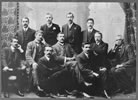A smaller flow
After the First World War Poland became an independent nation. The ‘push’ factors (the harsh conditions imposed by powers dominating Poland) declined and the ‘pull’ factor (assistance from the New Zealand government) ceased. The flow of migrants slowed.
The inter-war period
The next migrants from Poland were Polish Jews who arrived in the inter-war period as refugees from European anti-Semitism. They numbered at most a few hundred. Their Jewishness did not prevent them also identifying themselves as Polish, and they formed an association of Polish Jews in Wellington in 1944. This organisation later helped non-Jewish Polish migrants who arrived during and after the Second World War.
The Second World War
The Second World War devastated Poland, and many Poles were forced to leave. Three distinct groups with different war experiences arrived in New Zealand: children, war veterans and displaced persons. All shared the traumatic experience of being uprooted from their homeland.
Polish children
In 1943 New Zealand Prime Minister Peter Fraser, encouraged by Polish Consul General Kazimierz Wodzicki and his wife, invited a group of mainly orphaned Polish children to New Zealand for the duration of the war. A group of 734 children and 103 adults arrived in 1944. They had survived deportation to the Soviet Union, hard labour in Siberia, a terrible journey to the southern Soviet republics, and finally evacuation to Persia (Iran). They had witnessed the deaths of parents and siblings. At the end of the war, when Poland came under Soviet influence, the children were given the opportunity to settle in New Zealand.
The south Poles?
The Polish children’s camp near Pahīatua was called ‘Little Poland’ by locals. It was thought initially the children would return to Poland when the war was over, so they were educated in Polish. Their unusual situation – they came as temporary guests and then stayed as settlers – makes their story unique among New Zealand’s immigrant groups. ‘Little Poland’ recreated a world that they had lost, where they learnt to be patriotic Poles, although they did not return to Poland.
War veterans
This second group, mostly men who had children or family already in New Zealand, came immediately after the war. They numbered about 200 and had fought with the Allies, then found themselves outside Poland at the end of the war. They were given the same rights to settle in New Zealand as British ex-servicemen.
Displaced persons
Many of the displaced persons who came after the war had spent the war years in prisoner-of-war, labour or concentration camps in Nazi-controlled territory. They were often without identity papers. New Zealand belonged to the International Refugee Organisation that settled these people. More than 700 Poles were among the 4,500 displaced persons who arrived between 1949 and 1951.
The Cold War and the Solidarity movement
When Poland was in the Soviet sphere of influence at the end of the war, Poles had great difficulty obtaining passports. Polish migration virtually stopped during the Cold War period.
The next mass movement of Poles from Poland occurred in the 1980s with the rise of the Solidarity movement. This began with strikes in the Gdańsk shipyards in 1980, and led to a period of turmoil in Poland. In these troubled times, people flooded out of Poland into Austrian transit camps. More than 290 came to New Zealand.


